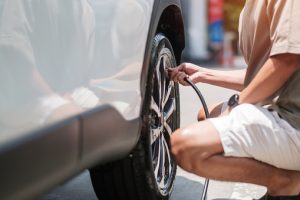With its innovative self-inflating tire technology, Goodyear is automating the maintenance of tire air pressure. Commercial testing has started.
If Goodyear’s revolutionary tire technology is successful, checking the air pressure in your car’s tires may become obsolete.
The unique Air Maintenance Technology (AMT), which has a clever, low self-inflating mechanism, is still being developed by the American tire company. The ingenious valve system connected to a tiny “pump tube” that travels the circumference of the tire and can automatically draw and expel air from inside the tire allows the new tire technology to manage the air pressure inside the tire. According to Goodyear, it eliminates the need for electronic equipment or external interventions to control inflation pressure.
The entire AMT system is housed inside the tire and functions by compressing a small pump tube that then pipes air into and out of the tire as needed to regulate air pressure. The little pump tube is compressed by the weight and motion of the tire itself.
The AMT tires maintained optimal air pressure for lengthy periods of time, according to Goodyear’s internal test results.
There are three main objectives for tire inflation systems:
Identify when a specific tire’s air pressure has declined. To do this, they must continuously (or occasionally) check each tire’s air pressure.

Inform the driver of the issue
Re-inflate the tire to the right pressure – This necessitates the presence of both an air supply and a check valve that only opens when necessary.
The available tire inflation systems have a variety of designs, but they all have several things in common.
To separate individual tires and stop airflow from all tires while one is being inspected or inflated, they all employ some sort of valve.
They have a system in place for measuring tire pressure. Most often, central sensors that transmit data to an electronic control system and then to the driver handle this.
They are equipped with an air source, which is typically an already present onboard source, like the braking or pneumatic systems. To avoid jeopardizing an established system’s original purpose, people must take care when using it. For this reason, before drawing air for tire inflation, safety checks are made to make sure there is enough pressure for the source’s primary usage.
The normal route for air to travel from the air supply to the tires is through the axle. Systems either run tubes through the axle, using the axle as a conduit, or they use a sealed-hub axle with a hose from the hub to the tire valve.
To release pressure from the tire without endangering the hub or rear-axle seals, a pressure relief vent is required.

There are three primary parts to the system:
In order to avoid pressurizing the air lines and seals when the system is not inspecting or inflating the tires, the tire hose assembly, which provides the air path to inflate the tire, incorporates check valves. The seals endure less abuse as a result.
The rotary joint joins the air hose from the non-spinning axle to the rotating hubcap. It is made up of oil and air seals and bearings. Its oil seal shields against contamination, while its air seals stop leaks. Additionally, the rotary hub incorporates a vent to let out trapped air in the hubcap.
This system has an electronic control unit that powers the entire thing. It checks the system’s functionality, runs system diagnostics, and alerts the driver through a warning light on the trailer (seen in the rearview mirror) if a tire’s pressure goes more than 10% below normal.
The system runs a preliminary pressure check and inflates any tires that require it. Each tire hose has a check valve to make sure the other tires don’t lose pressure as one tire is being filled. The system depressurizes after performing an initial pressure check to release pressure from the seals. The device pressurizes the lines and rechecks tire pressure every ten minutes.
A series of air pulses in the air lines are used by the system to measure tire pressure. The system starts pumping air into the tire(s) if the goal pressure in the line is not attained after a predetermined amount of time.
Controls
The system control module features a shut-off valve to prevent air from entering the system and a filter to get rid of impurities and moisture.
The air pressure of the entire system can be changed using a knob for system pressure control. When a tire is pumping in a lot of air, which could be a warning of a potential puncture, a flow-sensing switch activates the indicator light, alerting the driver.
